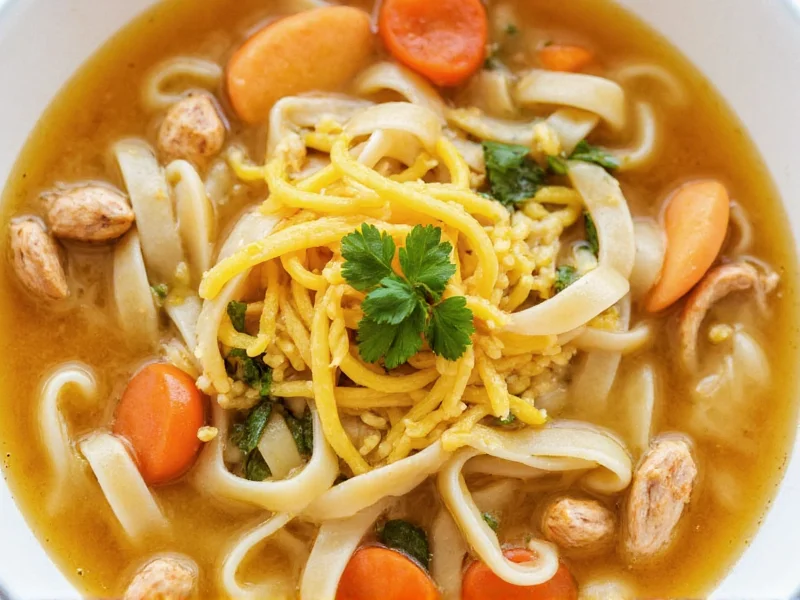When searching for the ultimate comfort food, nothing satisfies quite like a bowl of perfectly crafted chicken noodle soup. This timeless classic transcends mere sustenance—it's a culinary remedy that has warmed generations. The difference between ordinary and extraordinary chicken noodle soup comes down to technique, ingredient quality, and understanding the science behind flavor development.
What Makes Chicken Noodle Soup Truly Exceptional
Creating the best homemade chicken noodle soup requires attention to several critical components. Many home cooks make the mistake of rushing the process or using inferior ingredients, resulting in a broth that lacks depth. Professional chefs and culinary experts agree that the foundation of superior chicken noodle soup is a properly developed broth.
The Broth: Heart of the Soup
A truly exceptional broth begins with quality chicken bones—preferably a combination of backs, necks, and wings that contain ample collagen. Simmering these bones for 3-4 hours extracts gelatin that gives the soup its luxurious mouthfeel. Adding aromatic vegetables (mirepoix) during the last hour prevents them from becoming bitter. The ideal broth should gel when chilled, indicating proper collagen extraction.
Chicken Selection and Preparation
For the best chicken noodle soup, use bone-in, skin-on chicken pieces for maximum flavor. Poach chicken breasts or thighs separately in the finished broth rather than simmering them for the entire cooking time, which prevents the meat from becoming tough and stringy. Shred the cooked chicken by hand for better texture than using forks or processors.
Noodle Considerations
The choice of noodles significantly impacts the final product. Traditional wide egg noodles absorb broth beautifully while maintaining structure. Cook noodles separately and add them to individual servings to prevent them from becoming mushy in leftovers. For gluten-free options, rice noodles or quinoa pasta work well when added at the last moment.
Step-by-Step Guide to Perfect Chicken Noodle Soup
Follow this method for consistently excellent results that surpass store-bought alternatives and basic recipes:
- Build your foundation: Combine 2-3 pounds of chicken bones, 1 chopped onion, 2 carrots, 2 celery stalks, 4 garlic cloves, and fresh herbs in a large pot. Cover with 3 quarts cold water.
- Simmer gently: Bring to a boil, then reduce to the barest simmer for 3-4 hours. Skim foam regularly during the first 30 minutes.
- Strain carefully: Remove bones and vegetables through a fine-mesh strainer, pressing gently to extract liquid without forcing through bitter elements.
- Prepare chicken: Simmer 1 pound boneless chicken breasts in the strained broth for 15-20 minutes until cooked through. Shred by hand.
- Final assembly: Return vegetables to the broth with shredded chicken. Bring to simmer, add cooked noodles, and season with salt and freshly ground pepper.
| Component | Best Practices | Common Mistakes |
|---|---|---|
| Broth | Simmer bones 3-4 hours; add aromatics last hour | Boiling vigorously; adding vegetables too early |
| Chicken | Poach separately; shred by hand | Simmering entire cooking time; overcooking |
| Noodles | Cook separately; add to individual servings | Adding directly to pot; using stale noodles |
| Seasoning | Season in layers; finish with fresh herbs | Adding all salt at beginning; using dried herbs |
Avoiding Common Chicken Noodle Soup Mistakes
Even experienced cooks make critical errors that compromise their soup. Understanding these pitfalls ensures your homemade chicken noodle soup reaches its full potential:
- Rushing the broth: Proper collagen extraction requires time. Don't substitute store-bought broth if you want authentic flavor.
- Overcooking vegetables: Add delicate vegetables like peas or fresh herbs during the final 5 minutes to preserve texture and color.
- Incorrect seasoning timing: Salt in layers—some during broth preparation, more when assembling final soup. Taste and adjust before serving.
- Noodle neglect: Egg noodles continue cooking in hot broth. Undercook slightly when boiling to account for residual heat.
Variations for Dietary Needs and Preferences
The traditional chicken noodle soup recipe adapts beautifully to various dietary requirements without sacrificing flavor:
- Gluten-free version: Use rice noodles or gluten-free pasta, adding them just before serving to prevent disintegration.
- Low-sodium option: Control salt by using unsalted broth and enhancing flavor with lemon zest, fresh herbs, and umami-rich ingredients like mushrooms.
- Keto adaptation: Replace noodles with spiralized zucchini or shirataki noodles, adding them during the final minutes of cooking.
- Extra-nutritious version: Boost nutritional content by adding leafy greens like kale or spinach during the last 5 minutes of cooking.
Homemade vs. Store-Bought: What Nutritionists Recommend
While convenient, most commercial chicken noodle soups fall short in several critical areas. Registered dietitians consistently recommend homemade versions for these reasons:
- Homemade soup contains significantly less sodium (about 300mg per serving vs. 800-1000mg in canned varieties)
- Real chicken pieces provide complete protein rather than processed chicken byproducts
- Customizable vegetable content allows for increased fiber and nutrient density
- Absence of preservatives and artificial ingredients
- Superior flavor profile from properly developed broth
Storage and Reheating for Optimal Flavor
Proper storage techniques maintain quality when making chicken noodle soup ahead of time:
- Cool soup rapidly by placing the pot in an ice bath before refrigerating
- Store broth and solid components separately for best results
- Refrigerate for up to 4 days or freeze for 3 months
- When reheating, bring to a gentle simmer but avoid boiling to preserve texture
- Add fresh herbs and a squeeze of lemon juice after reheating to refresh flavors
The Science Behind Chicken Soup's Healing Properties
While often dismissed as an old wives' tale, scientific research supports chicken soup's reputation as a cold remedy. Studies published in the journal Chest demonstrate that chicken soup inhibits neutrophil migration, potentially reducing inflammation associated with upper respiratory infections. The steam helps clear nasal passages, while the warm liquid soothes irritated membranes. The combination of protein, vegetables, and hydration provides essential nutrients when appetite is diminished.











 浙公网安备
33010002000092号
浙公网安备
33010002000092号 浙B2-20120091-4
浙B2-20120091-4